Basketball Offense - Princeton Offense
By Dr. James Gels, From the Coach’s Clipboard Basketball Playbook"Helping coaches coach better..."
Disclosure: This page contains affiliate links, which means that Coach's Clipboard receives a small commission (at no cost to you) if you make a purchase using these links.
Writing an article about the Princeton offense is not an easy task as there is really no set "pattern" per se (such as the flex offense). Instead, it's more of a way of playing offense using certain principles that require offensive players to read the defense. For the most part, it is an unstructured free-lance offense that uses screens and cuts, with players reading and reacting to the defense.
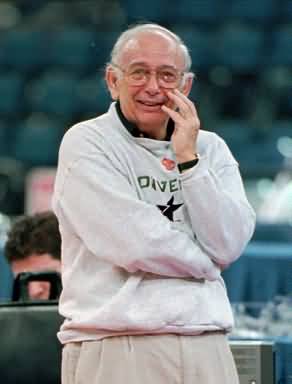
Princeton Coach Pete Carril
It has been said that this offense benefits a team whose players are less athletic than their opponents. But I disagree, as the Princeton offense requires all players to be good passers, ball-handlers (dribbling skills), and good outside shooters, as well as possess a high basketball IQ. If you have players like that, you can probably win with any offense!
Since players must have a good understanding of the game and know how to read the defense, this offense would not be an ideal choice for a youth or middle-school level team. This offense would benefit a team that lacks tall post players, but has good, smart perimeter players.
The Princeton offense is a more deliberate offense, oftentimes with many passes each possession. This tends to slow the game down, controlling the tempo, usually resulting in lower game scores. Coaches have to be completely committed to this offense as it is a free-lance offense with less control from the bench.
Certainly, however, plays and quick hitters can be called. The Princeton offense can be used against man-to-man and zone defenses. Against zones that pack the paint, open 3-point shots, attacking the gaps in the zone and attacking the baseline are effective techniques.
The hallmarks of the offense are the spread offense and spacing, constant motion, the back-door cut and lay-up, hitting 3-point shots, flare screens and screens away from the ball. The basic set can be a 2-3 high set, a 4-out with 1-in (either at the high post, or low post), or a 1-2-2 (5-out) set.
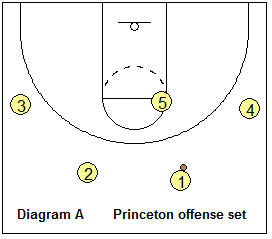
A smart post player with good passing skills is important as the offense will tend to revolve around the center, who is often a playmaker. When in the 4-out high or 2-3 high set (diagram A), all players are located at or above the free-throw line extended. This creates space underneath for cutting, especially back-door cuts. The high set and constant motion help eliminate inside helpside defense.
A variety of entries are possible - pass with give and go, UCLA cut, dribble-at with back-cut, high post feed, weave-screen, and high-post split (discussed in the Premium members section).
Basic Movement
A few rules to simplify things for your players:
- When players pass, they must cut and look for the give and go pass.
- The pass receiver should look to pass to the give and go cutter, look to shoot, and then use the dribble to either attack the hoop, or setup the next dribble-at, back-cut option.
- Use the dribble-at, back-cut. When dribbling at a teammate the options are to pass to the back-cutter, shoot, dribble-drive to the hoop, and dribble and kick-out to an open perimeter player.
- Always think about the back-door cut, and take it when it's there. This offense aims to get a lay-up off the back-door cut, or an open 3-point shot.
- Knock down the open 3-point shot when you get it.
Let's look at some basic movements to get an idea of some of the things the offense is trying to accomplish.
Diagram H shows O1 passing to O2 and cutting through. If O1 does not receive the pass, he/she bumps the X5 defender freeing O5 up for the pass at the high post from O2 (diagram I). O2 then screens for O3. If the X3 defender is over-playing (high), O3 back-door cuts for the pass and lay-up.
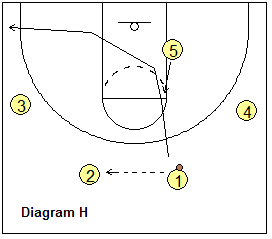
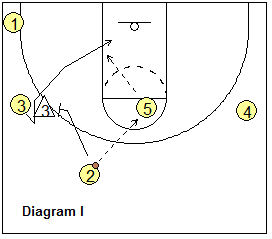
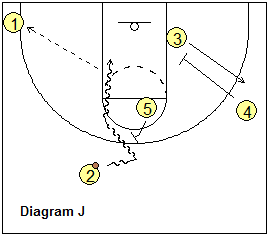
Instead of passing to O5 (the pass is denied), O2 dribbles at O5's ball-screen (diagram J). If the defenders jump over the screen, O2 changes the dribble to attack the up the left lane line. If the X1 defender hedges inside, the pass to O1 in the corner will be open. Notice that this same option could apply to O3 if instead of back-cutting, O3 came high off O2's screen in diagram I and received the pass from O5.
In diagram K, after O3 has back-cut through (as in diagram I), O2 pops back outside and gets the pass from O5. O5 ball-screens for O2 while O4 down-screens for O3. O2 might be able to dribble-drive to the hoop around O5's screen. If not, O2 could pass to O3 (diagram L), and O3 looks to pass inside to O4, who could have a mismatch in the post (after the down-screen).
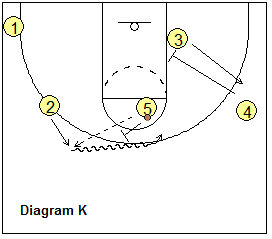
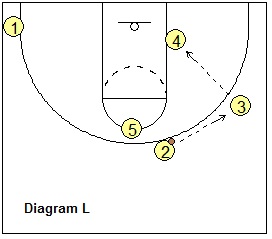
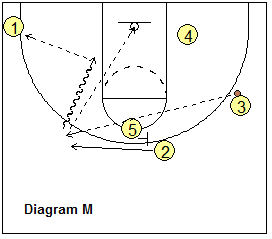
Diagram M shows O5 re-screening for O2. O2 cuts over the flare-screen for the pass from O3. If the X2 defender goes under the flare-screen, O2 has an open 3-point shot. If X2 chases over the top of the screen, O2 should be able to dribble-drive to the hoop. On the dribble-drive, if the X1 defender hedges inside, the kick-out pass is open to O1 in the corner for a 3-point shot. In diagram N, if the X5 defender switches on the flare screen and goes with O2, O5 slips the screen and cuts to the hoop for the pass from O3 and the lay-up.
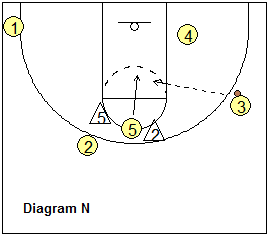
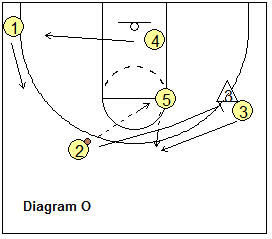
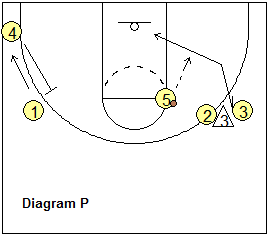
Diagram O shows O2 passing to O5 at the high post and then screening for O3. If the X3 defender goes below the screen, O3 should have an open 3-point shot after a pass on top from O5. If the X3 defender overplays on top of O2's screen (diagram P), O3 back-cuts for a pass inside and lay-up.
If O2 receives the pass from O5 (diagram Q), O5 ball-screens for O2. If the X2 defender goes below the screen O2 dribbles high over the screen for a possible outside shot. If X2 goes high on the screen, O2 attacks the hoop with the dribble. Meanwhile, O3 curls around the double-staggered screen set by O1 and O4.
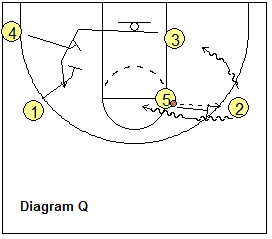
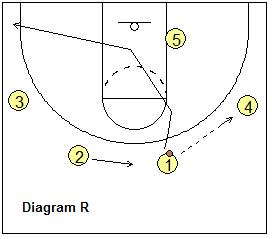
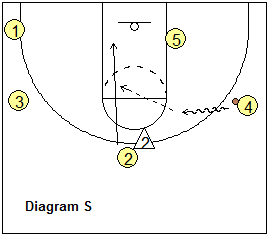
Diagram R shows another entry. O1 passes to O4 and cuts through to the opposite corner, and O2 replaces O1. O4 dribbles at O2. O2 back-cuts for a possible inside pass and lay-up (diagram S). If the pass to O2 is not open, O4 looks to pass inside to O5 posting up.
Passing Options from the Low Post
In diagram T, O5 has the ball in the low post. Now we'll show how our center O5 can be a playmaker. O4 slides to the corner (which is an easy pass back out from O5). O2 has already cut through and moves to the corner. O1 and O3 rotate up. O5 could skip pass back outside to O3 on the wing. If the X3 defender overplays and denies this pass, O3 back-door cuts to the hoop for the pass from O5.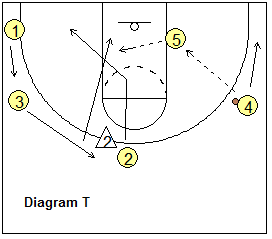
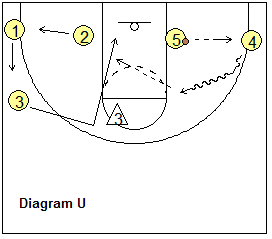
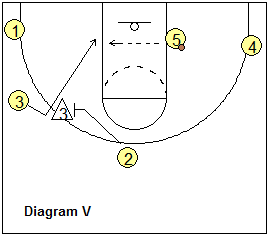
O5 could also pass back out to O4 in the corner (diagram U). Here, O4 dribbles into the top seam. O3 is in a good position to accept a kick-out pass from O4 if the X3 defender drops in to help stop the dribble. But if the X3 defender denies the pass out to O3, O3 should back-cut for the pass.
Diagram V shows another option with O2 screening for O3. If X3 overplays the screen, O3 back-door cuts for the pass from O5. This once again reiterates how in the Princeton offense, players being screened for should always be thinking of the back-door cut. The back-cut is the perfect counter for an aggressive, denying defense.
Diagram W shows another passing option for O5 from the low post. Here, O5 passes out to O2. O2 dribbles at O3, and O3 back-cuts for a possible pass, as O1 rotates up. If the back-door pass is not there, O2 passes to O1 (diagram X).
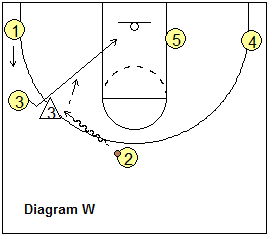
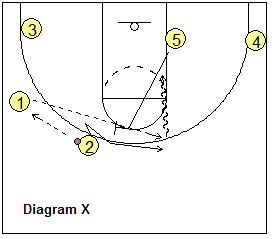
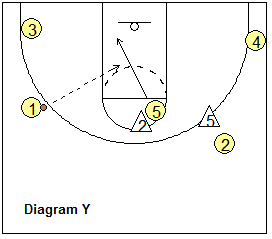
Meanwhile, O5 cuts up top to set a flare-screen for O2. O1 skip passes to O2 who could shoot the 3-point shot (if X2 goes under the screen), or dribble-drive to the hoop if X2 tries to chase over the top of the screen. If the defenders switch the flare-screen, O5 slips the screen and cuts to the hoop for the pass and lay-up (diagram Y).
Final Comments
The above diagrams are just a few examples of things that could happen - there is no set pattern. Players must have patience and an awareness of the shot clock in running this offense. The constant movement will tend to fatigue the defenders who are constantly chasing the offense and watching for cutters.Defensive boxing-out is more difficult when offensive players are moving. The helpside defenders are more easily confused and out of position when players are cutting and moving. And with screening, big-little mismatches can occur. "Big" defenders may find themselves trying to defend out on the perimeter, away from the hoop, where they are much easier to beat (by a quick guard), and are less of a rebounding threat.
See the complete article in the members section.
Sign up now!
The complete article also includes: The complete article includes several entries into the offense:
- UCLA cut
- Pass away and cut
- Ball-screen
- Dribble at, back-cut
- Weave-screen
- High-post split
Related pages:
- Pete Carril's Princeton Offense
- 7 Basic Actions of the Princeton Offense
- Princeton Offense Plays
- Muffet McGraw's Princeton Shooting Drills
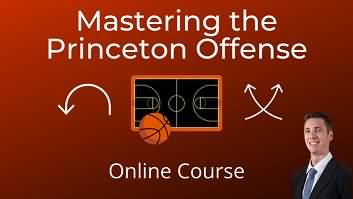
Coach Quinn McDowell has a new excellent online program, "Mastering the Princeton Offense". Any coach serious about the Princeton offense should sign up for this course. It includes a 47 page pdf that details and diagrams all the actions, quick hitters, drills, terminology, etc. There are many video clips including whiteboard discussions with Coach McDowell, and game video clips - film study - of teams running the offense.